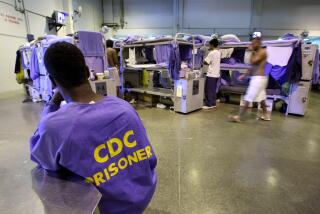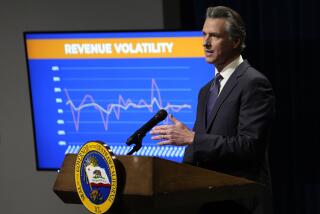Swelling Budget Gap Leaves Davis With Few Options
- Share via
SACRAMENTO--The plan in January, when Gov. Gray Davis faced what seemed to be a daunting $12-billion budget shortfall, was to stall and hope for the best. His spending proposal relied on borrowing, federal help and optimistic assumptions, and critics derided it as smoke and mirrors.
Four months later, with a new “real” budget plan due from the governor, the economic news has gotten worse, not better.
As Davis prepares release of his highly anticipated “May revise” budget Tuesday, the projected hole has grown to at least $20 billion and the options aren’t pretty.
Lawmakers expect the governor to propose deeper budget cuts than the $5.2 billion in trims he floated in January, to borrow even more money and--even though it’s considered politically risky in an election year--to consider a tax increase. State Sen. Steve Peace, the El Cajon Democrat who chairs the Senate Budget Committee, described the situation as “the toughest budget circumstance that any governor has had to face in [a] century.”
The most likely candidate for a tax or fee increase is thought to be the vehicle license fee, which has been rolled back about two-thirds since 1998 but with the caveat that the full fee could be restored if the state fell on hard times. Because of that provision, raising the fee may be considered the most palatable increase at the Capitol.
“This could be one of the options that closes the budget,” said Assemblywoman Carole Migden (D-San Francisco), who proposed legislation suspending the rebate. “As the summer swells, heat rises and so do the voices in the chambers. We’ll be forced to face some unpleasant realities.”
Whatever route Davis chooses Tuesday, it must overcome the challenge of closing the shortfall and still passing muster with lawmakers, voters and Wall Street.
“He’s got a problem,” said Assemblyman John Campbell, the Irvine Republican who leads his party’s caucus on budget matters. “If he raises taxes, he has a hard time with Republicans.... If he does everything with spending reductions, he may have some trouble keeping all the Democrats in line.”
After Davis revises his budget proposal Tuesday, the Legislature will have until June 30 to make its own adjustments and, by a two-thirds majority vote, send it back to the governor’s office. The deadline is frequently missed, however, and this year’s budget deliberations are expected to extend into July or beyond.
Davis has not revealed how he plans to address the budget gap. But legislative leaders say they expect him to propose a new round of spending cuts that--like those he suggested in January--will largely spare schools and police but not health and human services.
“A lot of the things we are going to have to do will cause a backlash from constituents,” said Assembly Budget Committee Chairwoman Jenny Oropeza (D-Long Beach). “People are accustomed to a level of state services that are just not going to be there.”
Advocates for struggling Californians are pushing for tax increases to help erase the state’s revenue shortfall.
“We think there ought to be a balanced approach,” said Jean Ross, executive director of the California Budget Project, a group that advocates for the poor during the budget process. “[Former Gov.] Pete Wilson understood that and [former Gov.] Ronald Reagan before him realized that if you have a substantial budget gap, you need to raise revenues.”
Wilson used a combination of cuts and tax increases during the early 1990s to close a $14-billion hole that materialized in a $42-billion general fund budget. Davis has to erase a $20-billion problem in a budget with about $75 billion in general funds.
“Certainly in dollar terms it’s the biggest problem we’ve faced,” said Brad Williams, senior economist with the state’s nonpartisan legislative analyst’s office. “Relative to the size of the budget, it’s starting to approach the magnitude of the early 1990s.”
But unlike Wilson, Davis is facing a multibillion-dollar shortfall in an election year. Perhaps consequently, the governor has made clear his desire to balance the state’s bank account without raising taxes while preserving funding for schools and local governments. Republicans are calling for a similar approach.
Complicating Davis’ ability to avoid a tax hike, however, is the state’s plan to borrow $7.5 billion to avoid a cash crunch this summer. Wall Street bankers may demand that the state have a bigger revenue stream in place for the deal to move forward.
The governor’s revised spending plan “is going to have to be real,” Peace said.
Other budget fixes, according to lawmakers, could include increasing the amount the state plans to borrow against its share of the national tobacco settlement from $2.4 billion to as much as $4 billion.
Lawmakers also are predicting that an unpopular proposal to defer state contributions to the California Public Employees’ Retirement System and the California State Teachers’ Retirement System may reappear.
Davis ditched the plan, which would free up hundreds of millions of dollars, in February. But lawmakers say it may return in a more palatable form that will cost the state less to repay.
So far, state officials have addressed about $4.3 billion of the shortfall through cuts and budget changes and by refinancing the state’s debt. Peace predicts that even if the state takes steps to borrow more and spend less, it will still face a $4-billion to $5-billion shortfall.
California’s budget problems have triggered concern among city and county officials that legislators will balk at paying local governments about $4 billion to cover the state-approved vehicle license fee rollback.
“There’s great fear, of course, that the vehicle license fee money will come into play at some point,” said Steve Zehner, a lobbyist and attorney for Los Angeles County.
The county gets about $770 million a year from Sacramento to cover the tax cut by state lawmakers. The money makes up more than half the county’s $1.1 billion in discretionary funds, which officials say have taken on new significance in light of Sept. 11 and the increased security and health-related costs the events spawned.
More to Read
Get the L.A. Times Politics newsletter
Deeply reported insights into legislation, politics and policy from Sacramento, Washington and beyond. In your inbox twice per week.
You may occasionally receive promotional content from the Los Angeles Times.










